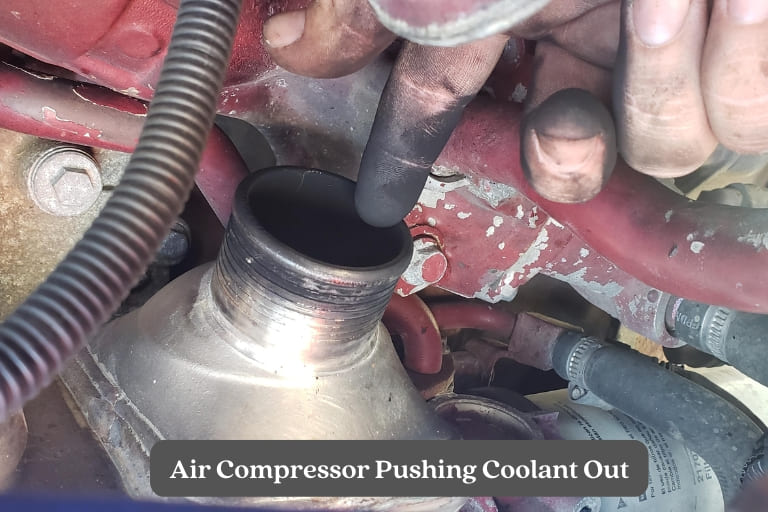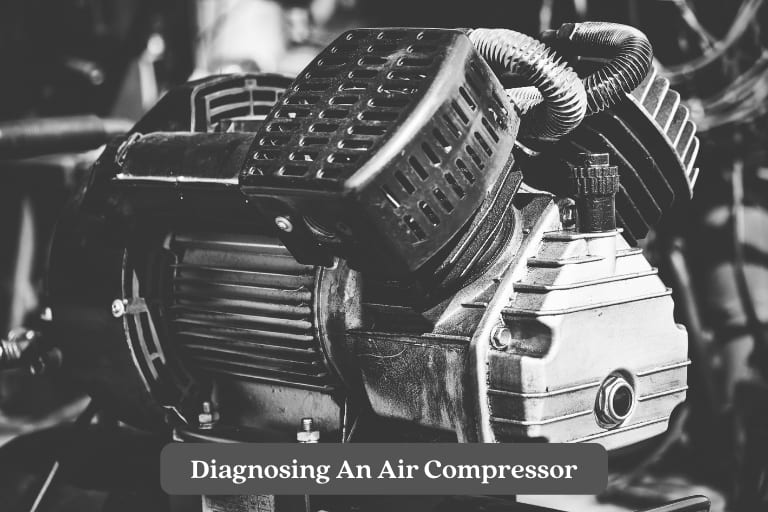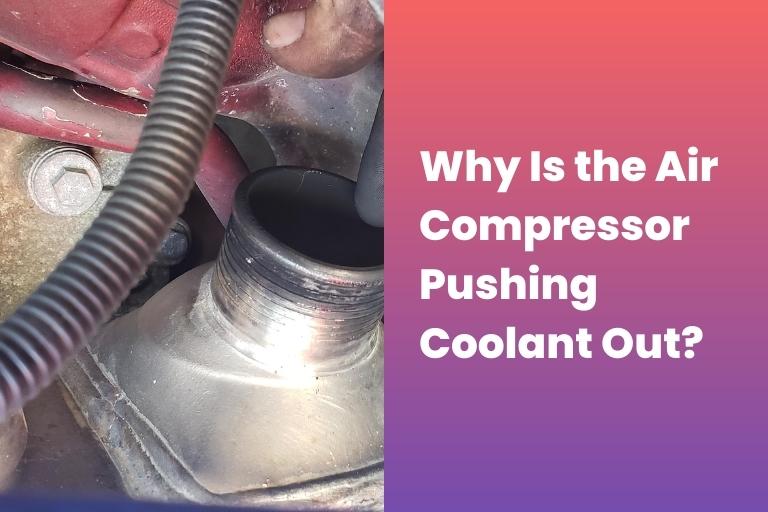According to some sources, up to 80% of air compressor failures are caused by problems related to cooling systems. You’re not alone if you’re experiencing coolant being pushed out of your air compressor. This common problem can lead to expensive repairs if not addressed promptly.
What could be causing this issue? Is it safe to continue using the compressor? How can you fix it?
In this post, we’ll explore the possible reasons behind coolant being pushed out of an air compressor and discuss the steps you can take to resolve the issue.
Contents
What Causes an Air Compressor to Push Coolant Out?

An air compressor forcing coolant out indicates a severe problem that must be treated immediately. There are several possible causes for this issue, but two common ones are a faulty pressure relief valve and a damaged gasket.
When an air compressor reaches a specific pressure level, the pressure relief valve is meant to open and discharge surplus pressure. If the valve is faulty, stuck, or damaged, it may not open properly, causing pressure to build up inside the compressor. This excess pressure can force coolant out of the compressor and cause damage to other parts of the system.
Another potential cause of coolant being pushed out of an air compressor is a damaged gasket. The gasket is responsible for sealing the cylinder head and preventing coolant from escaping. However, if the gasket is worn out, damaged, or cracked, it may allow coolant to leak out of the cylinder head and be pushed out by the piston during operation.
In all circumstances, resolving the problem as quickly as feasible is critical. Operating the compressor with coolant pouring out can cause substantial damage, resulting in costly repairs or perhaps replacement. Therefore, shutting down the compressor immediately and having a qualified technician inspect and repair the issue is recommended.
How to Diagnose an Air Compressor Pushing Coolant Out?

To diagnose an air compressor pushing coolant out, you need to check for visible signs of leakage and listen for unusual sounds from your air compressor.
Here are some steps you can follow:
Step 1: Turn off your air compressor and let it cool down entirely before inspecting it. This will help prevent accidental burns or injuries and allow you to check for leaks more effectively.
Step 2: Check the coolant level in your air compressor’s tank. If it is low, it may indicate a leak somewhere in your system. Add more coolant if needed and see if the problem persists.
Step 3: Check for any wet spots or stains around your air compressor’s tank, hoses, fittings, valves, and cylinder head. These may indicate where the coolant is leaking from. It’s essential to scrutinize these areas and note any visible signs of damage or wear.
Step 4: Listen for hissing or bubbling sounds from your air compressor’s tank or valves. These sounds may indicate too much pressure in your system or that your pressure relief valve is malfunctioning. If you hear any unusual sounds, it’s crucial to investigate the noise source further.
Step 5: Remove your air compressor’s cylinder head and inspect it for cracks or damage. It’s essential to check for any signs of wear or damage, including foreign matter on top of the piston that may be causing interference with the valve plate.
Thus, diagnosing an air compressor pushing coolant out requires a careful inspection of the system and a thorough check for visible signs of leakage and unusual sounds. By following these steps, you may assist in determining the source of the problem and taking the necessary actions to repair or replace any damaged components.
What to do if Air Compressor is Pushing Coolant Out
The solution to fix an air compressor pushing coolant out depends on the underlying cause. Here are some possible solutions:
- If your pressure relief valve is faulty, replace it with a new one that matches your air compressor’s specifications. A faulty pressure relief valve can cause excess pressure to build up in your system, leading to coolant being pushed out. Make sure to purchase a valve that is compatible with your compressor model.
- If your gasket is damaged, replace it with a new one that fits snugly between your cylinder head and piston. A damaged gasket can allow coolant to leak out of the system, causing coolant to be pushed out of the air compressor. Be sure to select a gasket that is the correct size and material for your compressor.
- If foreign matter is on top of your piston, clean it off using a soft cloth or brush and add a new gasket before reassembling your cylinder head. Foreign matter on the piston can cause interference with the valve plate, pushing coolant out of the air compressor. It’s crucial to ensure the area is clean before adding a new gasket and reassembling the cylinder head.
Fixing an air compressor pushing coolant out involves identifying the underlying cause and taking appropriate action to replace or repair the damaged components. If you need help with how to proceed, consulting a professional for assistance may be best.
Safety Precautions
Working with an air compressor pushing coolant out can be dangerous, so it is essential to follow proper safety precautions. Here are some tips to help you stay safe while repairing or fixing an air compressor:
- Use adequate personal protection equipment (PPE) such as gloves, goggles, ear plugs, and skin-covering clothes. PPE can help protect you from hazards such as coolant splashing or debris flying.
- Before checking or fixing your air compressor, switch it off and disconnect it. This will assist in preventing unintentional starts or electrical shocks. Additionally, waiting until the air compressor has cooled down completely is essential before touching any parts. Coolant can be hot and cause burns.
- Always follow the manufacturer’s instructions when replacing any parts on your air compressor. This will ensure the replacement part is installed correctly and the air compressor operates safely.
- Never exceed your air compressor’s maximum pressure rating. This can cause the pressure relief valve to fail, forcing coolant out.
- Do not use your air compressor for anything other than what it was designed for. Using an air compressor for an activity it was not designed for can be dangerous.
Why is Coolant Coming Out of the Overflow?
If you notice coolant being pushed out of an air compressor, it indicates a serious issue that requires immediate attention. This article explores the possible causes behind this problem, such as a faulty pressure relief valve and a damaged gasket. It also provides steps to diagnose the issue and offers solutions to fix an air compressor pushing coolant out.
Causes of Coolant Being Pushed Out:
Faulty Pressure Relief Valve: When the pressure relief valve fails to open properly, excess pressure builds up inside the compressor. This can cause coolant to be forced out of the system and potentially damage other components.
Damaged Gasket: The gasket is responsible for sealing the cylinder head and preventing coolant from escaping. If the gasket is worn out, damaged, or cracked, it can allow coolant to leak out of the cylinder head and be pushed out during compressor operation.
What to Do If Air Compressor Is Pushing Coolant Out:
The solution depends on the underlying cause. Here are some possible remedies:
- Faulty Pressure Relief Valve: Replace the valve with a new one that matches the compressor’s specifications.
- Damaged Gasket: Replace the gasket with a new one that fits properly between the cylinder head and piston.
- Foreign Matter on Piston: Clean the piston thoroughly and add a new gasket before reassembling the cylinder head.
It’s important to identify the cause and take appropriate action to repair or replace damaged components. Consult a professional if you need assistance.
Safety Precautions:
- Use appropriate personal protective equipment (PPE) like gloves, goggles, earplugs, and protective clothing.
- Disconnect the compressor and wait for it to cool down before performing any repairs.
- Follow the manufacturer’s instructions when replacing parts to ensure proper installation and safe operation.
- Adhere to the compressor’s maximum pressure rating to prevent the failure of the relief valve.
- Use the air compressor only for its intended purpose and avoid using it for activities it was not designed for, as it can be dangerous.
By following safety precautions and addressing the issue promptly, you can prevent further damage and ensure the safe operation of your air compressor.
Also, Check the following:
- Can Low Coolant Level Cause a Check Engine Light?
- Coolant Under Pressure When Cold
- 9 Signs You Need a Coolant Flush
- Coolant Coming Out of the Overflow
- Can You Put Ice in Your Coolant?
- What Happens if You Don’t Flush Coolant?
- Can Coolant Flush Cause Leaks?
- No Coolant in the Radiator, but Reservoir Tank is Full
- Do Cars Lose Coolant Over Time?
- Coolant Coming Out of the Radiator Cap When Removed
- Does Coolant Evaporate?
Conclusion
In conclusion, an air compressor pushing coolant out can be caused by a faulty pressure relief valve, a damaged gasket, or foreign matter on top of the piston. To diagnose this issue, it is vital to check for visible signs of leakage and listen for unusual sounds from the air compressor. Once diagnosed, it is crucial to promptly address the issue to prevent further damage and maintain the air compressor’s performance.
To fix this issue, replace the faulty pressure relief valve with a new one or replace the damaged gasket with a new one that fits snugly between the cylinder head and piston. Cleaning foreign matter on top of the piston is also essential before reassembling the cylinder head.
To guarantee adequate repairs, it is critical to take basic safety precautions such as putting on personal protective equipment, shutting off and disconnecting the air compressor, and implementing the manufacturer’s recommendations. Promptly addressing an air compressor pushing coolant out can prevent further damage and ensure the air compressor’s longevity and performance.
